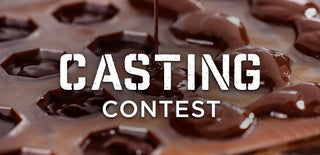Introduction: Casting Glass in a Microwave Oven
Watching a youtube video I've discovered that it was possible to melt glass in a micro-wave oven using a micro-wave kiln for glass fusing. Look at the video, but it is in french ;)
Have a look to this featured instructable too : Making Fused Glass Jewelry in a Microwave Kiln
With Ipxav, a maker friend of mine who lives nearby, we decided to give it a try and bought together the necessary tools.
We just needed a second hand micro-wave oven, and a micro-wave kiln. Melting glass in a micro-wave oven was impressive, but a bit limited. With tools at home I decided to go forward and try to make a mold with refractory plaster.
Be careful, the glass is very hot in the microwave kiln reaching temperature like 1000 celsius degrees and over, so be careful.
Step 1: Tools and Material
For this instructable, I've used a few things
- first, a micro-wave kiln for glass fusing
- then a second hand micro-wave you won't use for processing food
- wax to get a first simple form, I 've used wax from babyel cheese because it is free ;)
- and ice tray to get a a simple form out of melted wax.
- plaster and sand to make refractory plaster
- a cup that can enter the micro-wave kiln to make the refractory plaster mold in a correct size
- cups and spatula/spoons to make the plaster and melt the wax
- heat to melt the wax, an oven or a barbecue
- shards of glass for a bottle for example (green beer bottle in this case)
That's all
Step 2: Get a Positive Out of Wax
Melt the wax and pour it into an ice mold to get a simple form.
For a first test I've chosen to use a heart shaped ice mold.
Step 3: Make the Refractory Plaster Mold
Place the wax positive into a cup.
Make the refractory plaster using one part of plaster for two of sand. Mix and had water to get a fresh cream texture.
Pour in the cup, on the wax form.
Step 4: Remove the Wax
Once the plaster has taken, you can remove the wax using heat.
I've used a barbecue, to use free calories once the meal was cooked. One could use a traditional oven instead.
Then you can clean up the mold a bit and test it in the microwave kiln.
Step 5: Testing the Mold
Because it was a first try, I've used the mold empty at first, raising the time in the microwave in a few attempts.
I wanted to test that the mold won't break, or explode because of water in it, or take fire, or anything else damaging the microwave kiln or the microwave oven.
Everything was okay so I continued.
Each time the mold is heated it is weakened, but it seems strong enough to keep the same mold in the following steps.
Step 6: Finally Melting Glass
Place glass shards in the mold, and heat them in the microwave for a little more of a dozen of minutes, depending from the power of your oven.
As the glass melt and take less volumes once melted compared to shards, it is possible that you'll need to had more shards (once the mold is cold) on top of the previously melted glass and reheat one more time.
Step 7: Break the Mold
Once you are satisfied, and the mold is cold, you can break it to release the molded part.
As the intense heat has damaged the refractory plaster, it is easily broken with hands. I've obtained a heart made out of glass (from a beer bottle in my case ;) ). It is perfect and insert itself perfectly in the ice mold. Certainly it could be even better if I polish it, and I'll try it in the near future. But it was a first test before to go further, and I'm very happy it was something possible.
Remember, the glass is very hot and can be dangerous, take care.

Participated in the
Casting Contest













